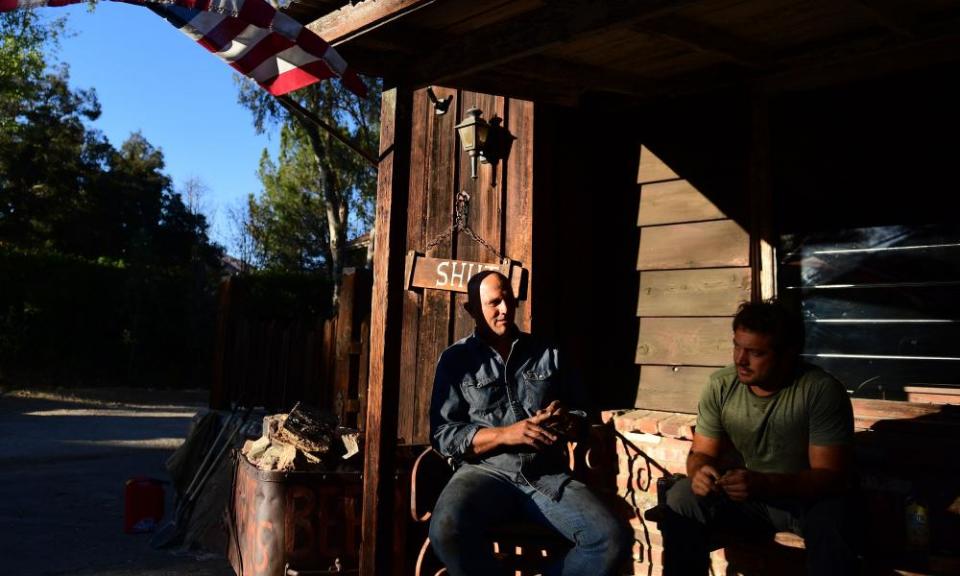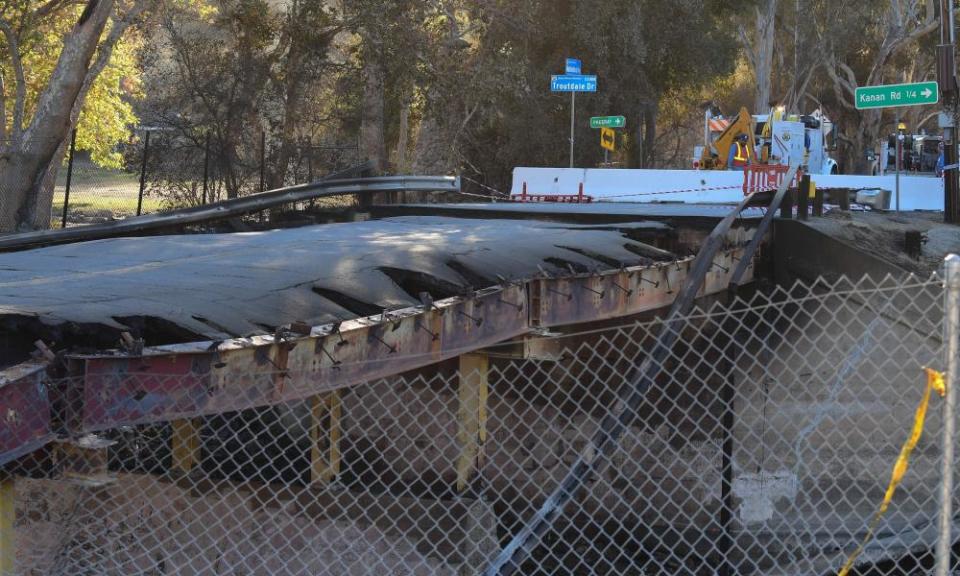California's DIY firefighters battle alone as the richest hire private teams

Even as black smoke filled the skies and flames swept the hillsides, residents of Cornell, California, hoped their homes would stay safe. Many in the small town tucked into the Santa Monica mountains had dealt with wildfires before and no one expected the fire would jump the freeway.
By dawn last Friday, the Woolsey fire – now considered the most destructive in Los Angeles county’s history – descended on Cornell. Stretched thin as they battled the enormous Camp fire in the state’s north, firefighters weren’t there to stop the flames from spreading.
“It came in so fast,” said a Cornell resident, Jeff Allen. “People barely got out.”
But Allen chose to stay. Determined to save his home and help his neighbors, he opted to risk it all and “just got the hose out”.
He was one of the many people who, when threatened by the southern California blaze this week, decided to fight rather than flee. It’s caused concerns among officials working to save lives, as fire crews struggled to contain the megafire that’s now burned across 98,362 acres.
But the fire department’s capacity crunch in the face of devastating and erratic fires has showcased a growing social divide. In areas where some residents felt the need to put their lives on the line, celebrities and affluent homeowners filled the gap with private firefighters to protect their mansions from burning.
In an article published last spring, NBC highlighted that the insurance giant AIG offers wealthy homeowners access to their Wildfire Protection Unit, certified through authorities to respond to fires that threaten million-dollar homes.
TMZ reported this week that Kim Kardashian and Kanye West hired private firefighters to protect their $50m mansion in the hills of Calabasas. It narrowly survived the fire, but critics began wondering if the destruction-fueled “new normal” meant the affluent, yet again, could save themselves while others suffered.

“This is not the ‘new normal’,” California’s outgoing governor Jerry Brown told reporters last Tuesday, amending the way he has previously described threats from worsening fires. “This is the new abnormal.”
The Los Angeles county fire chief, Daryl Osby, echoed his sentiments, saying climate change had taken a toll across the state. He called this the most difficult firefight of his career. California’s emergency resources, which the southern drier part of the state can typically rely on this time of year, were focused on the deadly Camp Fire, which erupted the same day north of Sacramento.
Until reinforcements arrived from other states, Osby said, the only objective they could achieve was to save lives and get everyone out. While the Camp fire, the most deadly in the state’s history, has claimed possibly hundreds of lives, three have reportedly perished in the Woolsey fire.
“I think we were successful at that objective, preventing death,” Osby said. “Unfortunately, it was at the expense of people’s homes.”
In Cornell, that meant residents were largely on their own.
“We had no help,” Allen said, recounting the inferno that cascaded through the canyon at shocking speeds.
He described the chaos as many of his neighbors scrambled to escape. Homes on the hill above him were already engulfed in flames when, around 8am, a sheriff’s car sped through announcing the mandatory evacuation order on a loudspeaker. Soon after, trucks and cars filled with evacuees hauled past in quick pursuit, only to find the winding canyon roads jammed farther down, with others trying to leave.

The fire department had yet to be seen.
“It looked like Armageddon,” Allen said. “Something you’d see in a movie and not real life.” Still, he and others stayed behind.
Residents teamed up throughout the weekend, defying evacuation orders, so they could try to help. Mark Sand rescued a barn full of horses, getting them into a pasture with sprinklers just as the flames closed in around them. Rich Savko protected the bar and restaurant his family has owned for 57 years – Rock Store, a favorite stop for motorcyclists, celebrities, and film crews.
Together, Allen and Sand rescued Thelma, a Shetland pony who was trapped in her corral, surrounded by fire. With moments to spare, they had to lift the singed and frightened pony into a truck to get her to safety. Sadly, their neighbor, Thelma’s owner, lost everything else that day. His beautifully cultivated home burned to the ground, with his dogs inside.
“I’d do the same thing again,” Allen said. “We did everything possible that we could, and it worked out.”
Officials have concerns over people who won’t heed calls to evacuate when ordered to. When residents opt to stay behind, often they need to be rescued. Sometimes they don’t make it out at all. It can make it harder for first responders to do their jobs, and put everyone at greater risk.
“We fully understand that each house is a home, each home has a life and memories attached to it,” the LA county sheriff, Jim McDonnell, told reporters during a press conference. But, he emphasized, “if you are being held back, it’s because your life and the lives of your family and neighbors are still potentially in danger.”
It’s not just tactical. “Things can change in an instant,” said the fire expert Sean Wolinsky, explaining that fires are more intense and erratic than ever before. Californians could be dealing with more deadly and destructive fires for the foreseeable future, and they should be ready.
“You obviously should evaluate life over property the best you can,” he added.
At the Rock Store, a donated generator brought the power back on by Monday, allowing Savko to offer passersby coffee, snacks, and meals.
Inside, where displaced neighbors and first responders congregated throughout the weekend, the TV blared the latest news – the fire’s third fatality had just been confirmed. Savko shook his head.
“It wasn’t our fight – we were just out there with little garden hoses trying to wet things down. That fire was just too fast and furious to really do anything.” But the fire crews “couldn’t keep up with it. They just didn’t have enough resources.”

 Yahoo News
Yahoo News 